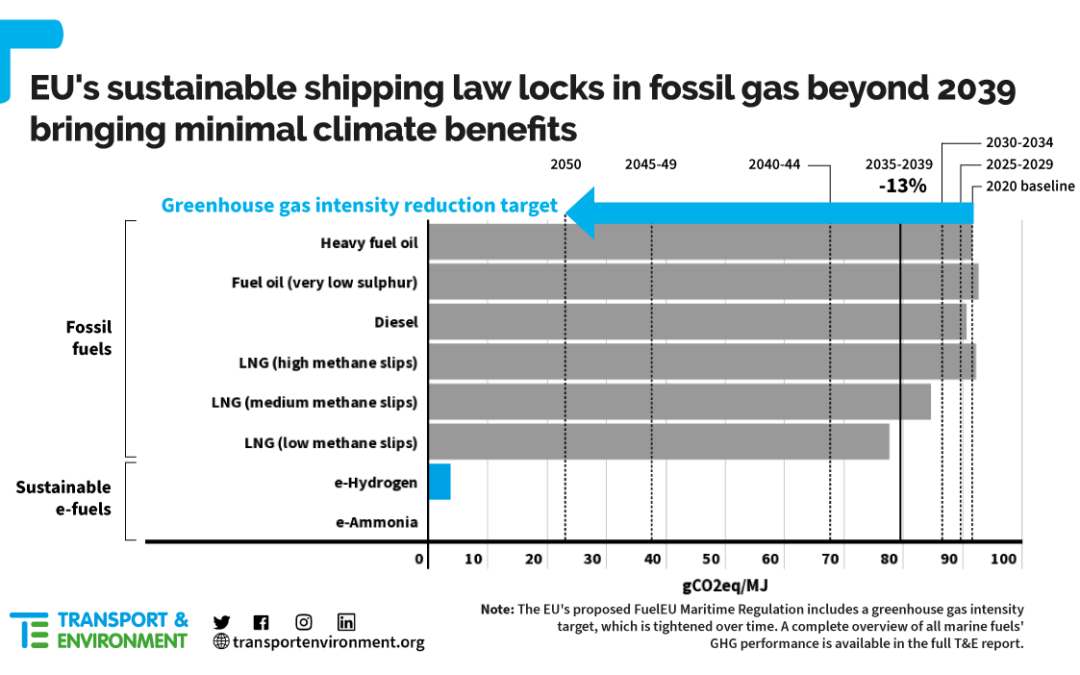A quarter of Europe’s shipping will be fossil gas-powered by 2030 as EU sustainability targets encourage an uptake of LNG. Transport & Environment (T&E) concludes this in its latest study. According to the NGO, this will lock-in fossil fuel use for decades. Interestingly, the NGO does not go into measures that would allow LNG-powered ships to operate more cleanly.
According to T&E the explanation of gas as a transitional fuel ‘doesn’t hold’. Delphine Gozillon, sustainable shipping officer at T&E: ‘We cannot afford to shift from one fossil fuel to another. It will not get us to zero emissions by 2050 and, by putting more methane into the atmosphere may even fry the planet faster.’
Last year, the European Commission proposed a law requiring ship operators to reduce the lifecycle carbon footprint of the fuels. The EU targets, which are tightened over time, are designed to gradually squeeze out the most polluting oil-powered ships.
Also read: ‘Unlike the Dutch, the Germans don’t write off LNG as a marine fuel’
According to the report, LNG will make up 23 per cent of the total energy used in EU shipping by 2030, up from six per cent today. It bases these numbers on ship order books for ships until 2023 with future LNG ship sales assumed based on the increase due to fuel oil being no longer compliant. LNG is the cheapest among alternative fuels.
LNG-powered ships will be allowed well into the 2040s. T&E argues that with 79 per cent of LNG burned in low-pressure four-stroke engines, these vessels have worse well-to-wake GHG emissions than traditional engines running on fuel oil. The NGO adds that if methane’s short-term global warming effects were accounted for, only the lowest-methane slippage engines would comply with FuelEU Maritime’s GHG targets.
‘EU proposals lack incentive’
According to T&E the current Commission proposal lacks incentive to switch to more sustainable alternatives such as green hydrogen or hydrogen-based fuels known as “e-fuels”.
Gozillon concludes: ‘Europe’s policymakers should introduce dedicated quotas and incentives to boost demand for hydrogen-based fuels. Genuinely clean solutions do exist, but currently they are expensive. If we kick start demand now, a green shipping future is possible. Continue to waste precious time on fossil gas and it will start to look impossible.’
Six per cent target by 2030
T&E recommends mandating a six per cent target for shipping e-fuels by 2030 as the most straightforward way to ensure supply and demand for sustainable fuels, while providing business predictability to shipowners and fuel suppliers. Without this minimum share of e-fuels and stricter greenhouse gas targets, full decarbonisation by 2050 will likely be out of reach.
The EU’s shipping fuel law – FuelEU Maritime – is currently under discussion in the European Parliament and the Council, with a final text expected in the second half of 2022.
Mitigating measures for use of LNG
T&E does not go into mitigating measures that the industry is working on for LNG powered ships. Engine manufacturers, including WinGD, Wärtsilä and MAN are working on solutions that reduce methane slip. In addition, ship design company Conoship International argued that the use of carbon capture can future-proof LNG-fuelled vessels.
Also read: Alfa Laval and WinGD present solution that targets methane slip / Conoship: Marine carbon capture future-proofs LNG-fuelled vessels








